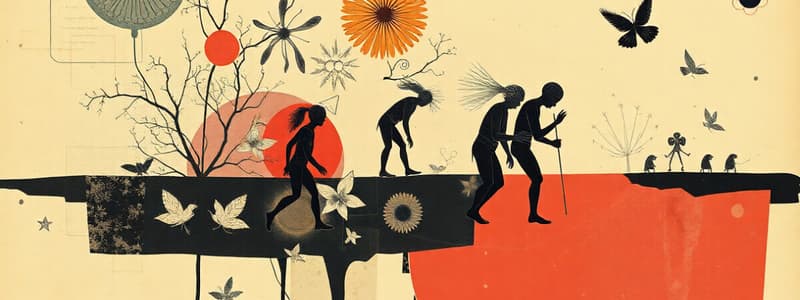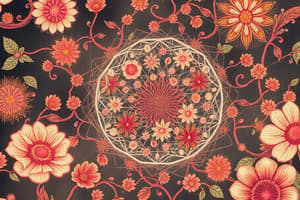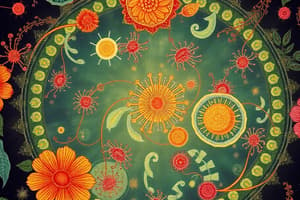Podcast
Questions and Answers
Which of the following best illustrates the concept of homeostasis in living organisms?
Which of the following best illustrates the concept of homeostasis in living organisms?
- The ability of a mammal to maintain a stable body temperature despite external fluctuations. (correct)
- The process of digestion breaking down complex molecules into simpler ones.
- The growth of a bacterial colony exponentially increasing in a nutrient-rich environment.
- A plant bending towards sunlight to maximize photosynthesis.
How do the principles of thermodynamics relate to living organisms?
How do the principles of thermodynamics relate to living organisms?
- Organisms completely defy the laws of thermodynamics by creating energy.
- Organisms decrease entropy without energy input, violating the second law.
- Organisms are closed systems that recycle energy without loss.
- Organisms transform energy to maintain order, increasing entropy in the surroundings. (correct)
If a scientist is studying the rate of photosynthesis in different types of algae to determine which could most efficiently convert sunlight into energy, which subdiscipline of biology is the scientist working in?
If a scientist is studying the rate of photosynthesis in different types of algae to determine which could most efficiently convert sunlight into energy, which subdiscipline of biology is the scientist working in?
- Anatomy
- Ecology
- Genetics
- Physiology (correct)
Which of the following statements accurately describes the relationship between genes and heredity?
Which of the following statements accurately describes the relationship between genes and heredity?
A researcher discovers a new single-celled organism that lacks a nucleus. Based on this information, how should this organism be classified?
A researcher discovers a new single-celled organism that lacks a nucleus. Based on this information, how should this organism be classified?
Which of the following biomolecules is primarily responsible for storing and transmitting genetic information?
Which of the following biomolecules is primarily responsible for storing and transmitting genetic information?
How does the cell theory relate to the understanding of life?
How does the cell theory relate to the understanding of life?
Which of the following molecules provides both insulation and long-term energy storage in animals?
Which of the following molecules provides both insulation and long-term energy storage in animals?
Which cellular component is primarily responsible for generating ATP through cellular respiration?
Which cellular component is primarily responsible for generating ATP through cellular respiration?
During which process is RNA synthesized using DNA as a template?
During which process is RNA synthesized using DNA as a template?
Which of the following best describes the role of enzymes in metabolic processes?
Which of the following best describes the role of enzymes in metabolic processes?
How does natural selection contribute to the process of evolution?
How does natural selection contribute to the process of evolution?
Which level of ecological organization includes both the living organisms and the non-living components of an area?
Which level of ecological organization includes both the living organisms and the non-living components of an area?
In the Linnaean system of classification, which level is more inclusive than family but less inclusive than phylum?
In the Linnaean system of classification, which level is more inclusive than family but less inclusive than phylum?
A mutation occurs in a cell that results in a non-functional enzyme. What is the most likely direct consequence of this mutation?
A mutation occurs in a cell that results in a non-functional enzyme. What is the most likely direct consequence of this mutation?
How do the fossil record and comparative anatomy support the theory of evolution?
How do the fossil record and comparative anatomy support the theory of evolution?
In an ecosystem, energy flow is unidirectional. What is the initial source of energy for nearly all ecosystems?
In an ecosystem, energy flow is unidirectional. What is the initial source of energy for nearly all ecosystems?
Which eukaryotic organelle is the primary site of photosynthesis?
Which eukaryotic organelle is the primary site of photosynthesis?
Flashcards
What is Biology?
What is Biology?
The scientific study of life, including its structure, function, growth, origin, evolution, and distribution.
Cell Theory
Cell Theory
All living organisms are composed of cells.
Gene Theory
Gene Theory
Hereditary information is encoded in DNA and genes.
Evolution
Evolution
Signup and view all the flashcards
Homeostasis
Homeostasis
Signup and view all the flashcards
Thermodynamics
Thermodynamics
Signup and view all the flashcards
Carbohydrates
Carbohydrates
Signup and view all the flashcards
Lipids
Lipids
Signup and view all the flashcards
Eukaryotic Cells
Eukaryotic Cells
Signup and view all the flashcards
Plasma Membrane
Plasma Membrane
Signup and view all the flashcards
Nucleus
Nucleus
Signup and view all the flashcards
Ribosomes
Ribosomes
Signup and view all the flashcards
Metabolism
Metabolism
Signup and view all the flashcards
Enzymes
Enzymes
Signup and view all the flashcards
ATP
ATP
Signup and view all the flashcards
Genes
Genes
Signup and view all the flashcards
Natural Selection
Natural Selection
Signup and view all the flashcards
Study Notes
The provided text duplicates the existing notes. There are no updates available.
Studying That Suits You
Use AI to generate personalized quizzes and flashcards to suit your learning preferences.



